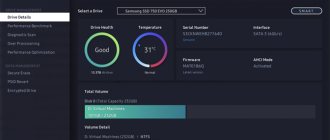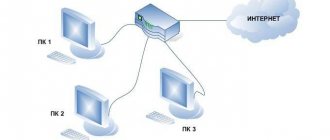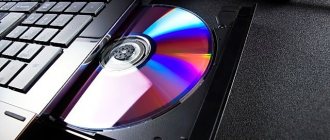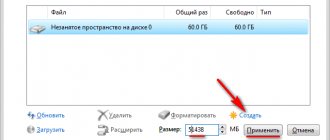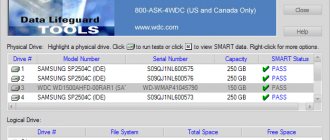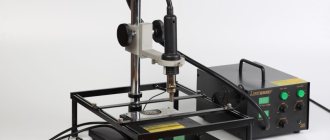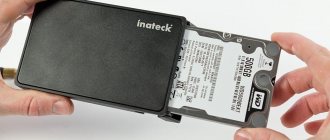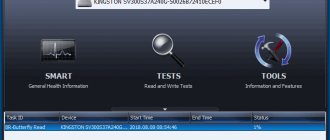Read what parameters should you pay attention to when choosing a hard drive?. How to buy exactly the device you need. Choosing a hard drive is not a simple process. It is important to buy a drive that will fully satisfy your needs for several years to come. In order not to be mistaken in the variety of available options, we will present you with several recommendations on the basis of which you can make a decision that suits you.
The essence of the problem
For work and leisure, entertainment and communication, education and information, computer devices are always indispensable assistants. The most common version of such devices and the most in demand is a personal computer. It doesn’t matter whether you are performing certain production tasks, developing new projects, managing any technological process, watching videos or listening to music, sending and receiving email correspondence, playing games or communicating on social networks, etc. – any process cannot be completed without his participation.
Personal computers have gained great popularity due to their enormous capabilities: increased performance, high performance and speed of information processing, a wide range of available applications for performing a variety of actions and solving various problems. Each element of a personal computer is responsible for its own specific process in the overall operation of the computer. Hard drives are key components of modern computers and are responsible for storing and processing information.
The amount of information we receive, process and use every day is growing steadily. We use more demanding software, which forces us to reserve a large amount of free disk space for its operation; we store a variety of personal information, photo and video archives, various arrays of media files, modern large games and applications, etc. All this, in turn, requires us to have reliable and high-speed disk storage.
Manufacturers of hard drives and drives are working to improve their products and are releasing more and more new models of their products onto the market. The new products have increased memory capacity and speed characteristics compared to previous models. They also strive to change the cost of the final product in the direction of reducing its price.
Quite often, due to the increased volume of stored data, the initially established amount of disk space for storing information is not enough. And users are starting to think about replacing the old hard drive with a new one or installing an additional drive on their personal computer. The user considers each option independently and chooses the most suitable one, based on his requirements and capabilities. The natural outcome of both options is the purchase of a hard drive, but choosing the ideal option from the wide range of available offers can be quite difficult.
We decided to give a few recommendations on what criteria should be used when choosing a new hard drive. By following them, you can choose the version of the required disk in accordance with your preferences.
Hard drive "HDD" or solid state drive "SSD"
The main question you need to answer is what type of storage device you will choose: HDD
or solid state drive
"SSD"
. Both devices, disk and drive, perform the same function of storing data, but each has its positive and negative sides.
Hard drive "HDD"
is a storage device that records information on rigid aluminum or glass plates coated with a layer of a special material.
Solid State Drive "SSD"
is a non-mechanical storage device based on semiconductor flash memory technology used to record and store information.
If we compare these two types of devices, then according to some types of parameters, the solid state drive “SSD”
has an advantage over a conventional
HDD
.
For example:
- SSD
drive reads and writes data an order of magnitude faster than an
HDD
; - SSD
drive consumes less energy, which saves energy and extends the life of the laptop battery; - An SSD
has no moving parts, so it does not create noise and has a longer lifespan than an
HDD
.
In turn, the hard drive “HDD”
has a number of advantages:
- Incommensurably (6-7 times), the cost of an HDD is
lower compared to the cost of an
SSD
of the corresponding volume; - An HDD
is much less sensitive to electrostatic discharge than an
SSD
; - SSD
drive has significantly less wear resistance (writing life) compared to a
HDD
.
Incomparably low price and sufficiently large volume of hard drive memory, compared to the same volume of an SSD
, makes the
HDD
indispensable when used as a backup disk.
In turn, the high performance of the SSD
allows you to use it as a boot disk to run the operating system and various applications.
You can read more about the differences between hard drives and drives, as well as the different ways to install them, in our earlier article: “How to update and install a new hard drive or SSD drive in a personal computer?”
.
Hard drive sizes and interfaces
Once you have decided which of the two drive options best suits your requirements, you must decide on its size (the so-called form factor). It will mainly depend on what drive you have chosen and where you plan to use it.
There are two main options for disk sizes: “3.5-inch”
disk and
"2.5-inch"
disk.
Additionally, there is another disk option with the “M.2”
, which is used to implement high-performance solid-state drives (used in some tablets and ultrabooks). These drives look more like a memory stick than a standard hard drive. To use disks of this standard, you must determine whether your computer supports this type of connection (check for the presence of a specialized slot).
Hard drives "HDD"
Available in both sizes.
Personal desktop computers use a standard “3.5-inch”
HDD.
Since its capacity directly depends on the number of installed platters and their size, manufacturers use the maximum allowable size of “3.5-inch”
, which allows them to produce hard drives with a capacity of
“16 TB”
.
If you have “2.5-inch”
drive, then you can also install it in a personal computer using a special mounting bracket.
"2.5-inch"
Hard drives are designed and used in laptops because the amount of free internal space is limited by the laptop case.
By reducing the size of the hard drive, the usable area of the internal disk platters is reduced, so the maximum volume of such a disk does not exceed “4 TB”
today.
Solid State Drives "SSD"
have a
2.5-inch
. Due to the absence of moving parts, their size can be reduced to a lower standard without losing the quality of the drive, and allows it to be used in computers and laptops.
The method of connecting the hard drive and storage device is the same for both types of drives, and is done through “SATA”
, which are used in most modern computers.
In addition to the built-in drives ( "HDD"
and
“SSD”
), you can also use external drives, which are connected to the computer via a
“USB cable”
. The main advantage of such devices is their mobility.
Overclocking
Experienced users know that almost any component of the system can be improved. Therefore, it is not surprising that many people want to know how to increase the speed of their hard drive.
Of course, you can go deeper into this issue and understand the technologies for overclocking a hard drive, but there is a big risk that an inexperienced user can damage the device, which will lead to system failures. Therefore, many suggest regularly performing some operations that will help, albeit slightly, but still speed up the work of the railway.
It is advisable to check the disk regularly. To do this, you need to go to “My Computer”, select one of the sections and right-click on it. Then select “Properties” and go to the “Service” tab. Here you can defragment the disk.
Hard Drive Features and Performance
Now that you have decided on the type of drive and have decided which option is most suitable for you, it is time to choose a drive that has the optimal characteristics to meet your requirements.
Below are the main characteristics that explain the capabilities of each drive. Having considered each of them, you will be able to understand and, based on the knowledge gained, determine the characteristics of the disk model that meets your requirements.
- Storage capacity:
Today, the maximum volume of a hard drive is
“16 TB”
, due to the limitation of its overall dimensions.
In turn, “SSD”
have a smaller capacity compared to
“HDD”
up to
“4 TB”
.
“SSD”
with a capacity of more than
“1 TB”
for their own needs .Although there is already an "SSD"
with a capacity of
“32 TB”
from the
Samsung
, but it is designed for corporate clients due to its sky-high cost.
Additionally, at the sample level for now, it presented “60 terabyte” “SSD”
drive, and in the plan, the development of a
“100 TB”
. - Disk speed
: This value consists of many factors.
HDD
hard drives , an important operating parameter is the access speed - the average value of the time it takes to receive a unit of information. It shows how quickly the hard drive's internal mechanism can find the data it needs. And the higher it is, the faster the information will be processed and, accordingly, the less time it will take to record it.Since "SSD"
Disks do not have mechanical moving parts; the important parameters for them are read speed and write speed. The higher both of these values are, the less time the system will spend processing information. Of two drives of the same capacity, but with different read and write speeds, the drive whose speed parameters are higher will copy and load files faster.
HDD hard drives
is the spindle rotation speed.
It is indicated on the disk and is available from “5400 rpm.”
up to
"15000 rpm"
.
Basically, the average user chooses between the values “5400 rpm.”
and
“7200 rpm.”
. Drives with higher spindle speeds are used for continuous operation servers. The higher the rotation speed, the faster the disk head will find the desired track of information. - Buffer volume
: Disk buffer capacity is the built-in internal memory used for processing, managing and storing data.
Accordingly, the larger the disk buffer capacity, the faster you access data on the disk. Hard drives have different disk buffer sizes and the range is from "16 MB"
to
"256 MB"
. However, if you plan to use the drive only for storage, then there is no point in buying an expensive drive with a high buffer capacity. - Failure Rate
: This is a kind of safety margin for the drive.
Hard drives are made up of mechanical parts that are subject to wear and tear, which in turn can lead to the loss of all information contained on the drives. No one can say with complete confidence which of the disk models will fail in the near future, and which will be able to serve you for its full cycle. In this case, you should pay attention to the reviews of specific users who have had experience working with certain drive models and have rendered their verdict. And also take advantage of your own experience in using disks from certain manufacturers. Solid state drives (SSDs)
have no mechanical parts and store all information on memory chips, so they are more durable than hard drives
(HDDs)
.
But, if you plan to use the disk as a removable backup data storage, then the reliability of a hard drive looks more preferable to the reliability of an SSD
.
Device operation
What is a hard drive needed for, and how does its speed affect performance? The storage device stores data and gives free access to it. The mechanism is built on magnetic recording.
From the outside it won't be easy to figure out how to find out the speed of your hard drive. Under the plastic case there are magnetic disks and a read head. In working condition, it does not touch the plates. The minimum distance between parts ensures the process of reading and writing information due to air flow.
Now the hard drive is increasingly receiving criticism from users. Especially after the advent of the solid state drive. Thanks to SSD, users learned that the system can have a faster drive that can easily cope with the most resource-intensive tasks.
But so far, solid-state drives are very expensive, so most people use only a combined option or prefer to do without an SSD altogether.
Cost of hard drives
The number of hard drives and solid state drives on the market today is unusually large. Manufacturers are discontinuing old models and replacing them with new ones with improved characteristics. Hard drives initially have a much lower price compared to solid state drives of the same capacity.
Armed with knowledge of the basic characteristics of disks and choosing its type, you can, based on pricing policy, choose a hard drive or solid-state drive that fully meets your needs and meets your financial capabilities.
For example, for the same price, you can purchase either a slow, high-capacity hard drive, or a high-speed drive, but one that has a small capacity compared to a disk. It all depends on what specific tasks you are purchasing this data storage device for. The optimal solution would be to use a hard drive to store information, and a solid-state drive to install the operating system on it and run modern applications and programs.
An important evaluation criterion when choosing a specific disk can be the cost of one gigabyte of information, determined by dividing the cost of the disk by its capacity. For example, when choosing between two disks 1TB and 2TB, you will see that the price of the second disk is naturally higher than the price of the first. But if you compare the cost of one gigabyte of information on each disk, you will see that for the second disk it is lower than for the first. Therefore, by purchasing a second disk, you will receive greater capacity, but at a lower price per unit of information. But in any case, the decision on the final choice of disk will be consistent with your financial capabilities and ability to spend a certain amount on purchasing a disk.
These conclusions are equally true for HDD hard drives.
and solid state drives
"SSD"
.
Setting up CrystalDiskMark and AS SSD Benchmark
Before you start scanning a program, you need to configure it. The first step is to select the number of cycles. Many people recommend leaving the default value. Next, you need to set the size of the file that will contain the test results. 1 GB will be enough.
Below you need to specify the disk that needs to be analyzed. It all depends on which section interests the user. Finally, you need to click the “All” button and start testing.
External or internal hard drives
The next step in choosing the drive you should consider is deciding what kind of drive it will be: internal, installed in the computer case, in a portable case, or a plug-in external drive.
An external connectable drive can be used to store any of your information that is not required to be accessed every day (personal files and documents, photo albums, video archives, etc.), backup files. You can connect it to your computer at any time via a USB cable.
and download or upload any data.
Accordingly, the higher the version of the universal serial bus “USB”
used for connection, the higher the speed of data transfer from the disk to the computer and back.
The main advantage of such disks is their mobility. You can easily connect them to different computers to exchange information. Or connect them to a TV or set-top box to transmit the required content directly (for example, to play photos or home video recordings).
In other cases, it is preferable to opt for internal drives.
You can use any drive in a special portable case to connect it to your computer. And be able to take it out and use it on another device at any time. The main requirement is to use the correct case with the appropriate connectors to connect such a drive. For example, using a special case, you can connect the disk to your computer, save the necessary information and turn it off so as not to additionally load the operating system and protect your information from possible troubles (for example, system failure, virus attack, etc.).
If the internal space of the hard drive is not enough for full-fledged work, then it makes sense to install a hard drive “HDD”
large capacity. You can replace the old disk with a new one, or install an additional disk to increase the available disk space, if the internal configuration of the computer allows it.
If the main requirement is system loading speed and increasing the performance of the computer as a whole, then use an SSD.
.
By installing a drive instead of an HDD
, you will immediately see a noticeable increase in data processing speed and performance of your computer.
The most optimal, in our opinion, is to share two disks: an “SSD”
define as the system disk for installing the operating system, and
“HDD”
as the data storage.
Software components
To check the read and write speed of a hard drive, you need to use a special command. But to do this you need to launch Command Prompt. In “Start” you need to select the “System” section, and then Windows. In the new window you can find “Command Prompt”. Next, right-click (RMB) to start the service as administrator.
You can also use the key combination Win + R, where “Win” is the operating system icon on the keyboard. In the “Run” line, enter the “cmd” command.
To test the hard drive, you must enter the command “winsat disk” without using quotes. The system will collect all data about the device and display it in a dialog box. What should you pay attention to?
Disk Random 16.0 Read, Disk Sequential 64.0 Read and Disk Sequential 64.0 Write. The device performance index will also be indicated, which can also be found in the system properties.
To obtain additional data about the hard drive, you must enter the necessary commands without leaving the Command Line. For example, to determine the reading speed, enter “-read”, write - “-write” (without quotes).
Games: hard drive for PlayStation and Xbox 360
The choice of hard drive can have a significant impact on gaming performance, so we always recommend using an SSD
instead of a hard drive
"HDD"
.
This is true for different types of devices: personal computer, Xbox One
,
Xbox One X
,
PlayStation 3
,
PlayStation 4
,
PlayStation 4 Slim
,
PlayStation 4 Pro
or any new gaming console.
Since the speed of the "SSD"
significantly exceeds the speed of
the HDD
, then games will launch on it much faster and switch between levels, stages and maps.
In games this difference is most noticeable. Therefore, do not regret and purchase an SSD
if you plan to use it for games.
Otherwise, the disappointment from using the HDD
will be much greater than the satisfaction from the money saved.
When choosing a disk, you must adhere to the requirements of the specific device parameters:
- For a personal computer
: Any hard drive will work as long as you use the correct size drive in your computer case and the correct types of connections to your motherboard.
Again, these are most likely "3.5"
drives for desktop computers and
"2.5" drives
for laptops, and SATA connections are the most common. - For
Xbox 360
Xbox 360
console uses
2.5-inch
hard drives installed by default.
To upgrade or replace such a drive, you will need to purchase one of the overpriced replacements offered by Microsoft
.
And to use third-party drives, you need to run special firmware that is compatible with Xbox
. - For
Xbox 360 S and E : The hard drives used in the
Xbox 360 S and E
Xbox 360
console and vice versa.
"4GB"
models have internal flash memory that cannot be removed or replaced.
"250GB"
models can be upgraded to
"500GB"
by purchasing one of
Microsoft
. - For
Xbox One : The
Xbox One
supports external drives via a
USB 3.0
, which means you can use almost any
SSD
. Unfortunately, there is no easy way to replace the internal drive. - For
"Xbox One X" :
"Xbox One X"
also supports external drives via a
"USB 3.0"
with a minimum size of
"256GB"
. In this case, there is also no easy way to replace the internal drive, and doing so will void the warranty. - For
PlayStation 3
PlayStation 3
models have
2.5-inch SATA drives
, which can be easily replaced and upgraded by users without any problems. - For
PlayStation 4 : all
PlayStation 4
, including the
Slim
and
Pro
, have
2.5-inch SATA drives
, which can also be replaced and updated by users absolutely painlessly.
Additionally, they support external hard drives via a USB 3.0
.
Examination
How to check the speed of your hard drive? Of course, the first thing that comes to mind in this case is special utilities. Thanks to the program, you can find out any parameters of the hard drive, as well as scan the device for errors.
But not only software can help you learn how to check the speed of your hard drive. Thanks to the software components of the computer, it is also possible to analyze the device parameters.

